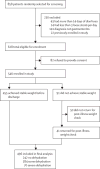External validation of the DHAKA score and comparison with the current IMCI algorithm for the assessment of dehydration in children with diarrhoea: a prospective cohort study
- PMID: 27567350
- PMCID: PMC5066390
- DOI: 10.1016/S2214-109X(16)30150-4
External validation of the DHAKA score and comparison with the current IMCI algorithm for the assessment of dehydration in children with diarrhoea: a prospective cohort study
Abstract
Background: Dehydration due to diarrhoea is a leading cause of child death worldwide, yet no clinical tools for assessing dehydration have been validated in resource-limited settings. The Dehydration: Assessing Kids Accurately (DHAKA) score was derived for assessing dehydration in children with diarrhoea in a low-income country setting. In this study, we aimed to externally validate the DHAKA score in a new population of children and compare its accuracy and reliability to the current Integrated Management of Childhood Illness (IMCI) algorithm.
Methods: DHAKA was a prospective cohort study done in children younger than 60 months presenting to the International Centre for Diarrhoeal Disease Research, Bangladesh, with acute diarrhoea (defined by WHO as three or more loose stools per day for less than 14 days). Local nurses assessed children and classified their dehydration status using both the DHAKA score and the IMCI algorithm. Serial weights were obtained and dehydration status was established by percentage weight change with rehydration. We did regression analyses to validate the DHAKA score and compared the accuracy and reliability of the DHAKA score and IMCI algorithm with receiver operator characteristic (ROC) curves and the weighted κ statistic. This study was registered with ClinicalTrials.gov, number NCT02007733.
Findings: Between March 22, 2015, and May 15, 2015, 496 patients were included in our primary analyses. On the basis of our criterion standard, 242 (49%) of 496 children had no dehydration, 184 (37%) of 496 had some dehydration, and 70 (14%) of 496 had severe dehydration. In multivariable regression analyses, each 1-point increase in the DHAKA score predicted an increase of 0·6% in the percentage dehydration of the child and increased the odds of both some and severe dehydration by a factor of 1·4. Both the accuracy and reliability of the DHAKA score were significantly greater than those of the IMCI algorithm.
Interpretation: The DHAKA score is the first clinical tool for assessing dehydration in children with acute diarrhoea to be externally validated in a low-income country. Further validation studies in a diverse range of settings and paediatric populations are warranted.
Funding: National Institutes of Health Fogarty International Center.
Copyright © 2016 The Author(s). Published by Elsevier Ltd. This is an Open Access article under the CC BY license. Published by Elsevier Ltd.. All rights reserved.
Conflict of interest statement
Declaration of interests We declare no competing interests.
Figures





Comment in
-
Improving management of dehydration in children younger than 5 years in low-and-middle-income countries.Lancet Glob Health. 2016 Oct;4(10):e674-5. doi: 10.1016/S2214-109X(16)30179-6. Epub 2016 Aug 23. Lancet Glob Health. 2016. PMID: 27567347 No abstract available.
References
-
- WHO. The treatment of diarrhoea: a manual for physicians and other senior health workers. Geneva: World Health Organization; 2005.
Publication types
MeSH terms
Associated data
Grants and funding
LinkOut - more resources
Full Text Sources
Other Literature Sources
Medical

